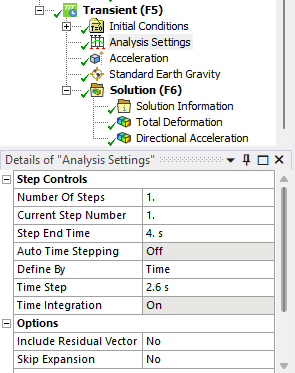-
-
April 28, 2022 at 2:04 am
Ichinisan
SubscriberI am a beginner in Ansys. I've only started working on the software for the past four months. Now, I am working on a study using linear time history. One of my goals in this study is to compare the results from the linear time history I initiated in Ansys to other structural analysis software like Etabs to validate the results.
I performed linear time history in Ansys through modal and transient analysis, and I'm looking for the displacement of the structure when subjected to acceleration. However, I am having a hard time matching the results of Ansys with Etabs.
I have tried to make the loads similar in Etabs and Ansys and have successfully matched the results of the modal analyses from each software after several attempts. But the results in the transient analysis are still far from each other. Since I am more familiar with Etabs, I am sure that I have performed the linear time history analysis well in that software.
However, Ansys has a different interface and features than Etabs. I am not sure whether I have performed the analysis well in Ansys because it produces small values compared with Etabs, especially while using the transient analysis.
I think that perhaps, the analysis settings in the transient analysis of Ansys have something to do with the discrepancy between the results. I believe there is a need to input the correct time step. However, I am still having trouble defining such value. Can anyone please help me?
April 28, 2022 at 2:00 pmChandra Sekaran
Ansys EmployeeWhat is the time step size used in ETABS? Here you have specified a time step size of 2.6 seconds but the end of the transient is only 4 seconds. So you are really doing only 2 solutions - one at 2.6 seconds and next at 4 seconds. You mentioned the modal analysis is good. Take a look at the frequencies and mode shapes. The general rule of thumb is to put 20 points per cycle at the highest frequency that you want to resolve. So for example if the highest frequency of interest is 100 Hz then the time step size will be 1/(100*20) seconds following the above rule of thumb. I think your time step size is not right.
May 5, 2022 at 1:17 pmIchinisan
SubscriberHello! Thank you for responding to my question. I have now corrected my time step size, and I have already matched the data from ETABS and Ansys. I figured out how to get the correct time step size, and the formula you've given verified the process I initiated. Thank you so much for shedding some light on my research.Cheers!
Viewing 2 reply threads- The topic ‘Time Step in Transient Structural (Analysis Settings)’ is closed to new replies.
Innovation SpaceTrending discussions- LPBF Simulation of dissimilar materials in ANSYS mechanical (Thermal Transient)
- Real Life Example of a non-symmetric eigenvalue problem
- How can the results of Pressures and Motions for all elements be obtained?
- BackGround Color
- Contact stiffness too big
- Element Birth and Death
- Python-Script to Export all Children of a Solution Tree
- Which equations and in what form are valid for defining excitations?
Top Contributors-
4597
-
1495
-
1386
-
1209
-
1021
Top Rated Tags© 2025 Copyright ANSYS, Inc. All rights reserved.
Ansys does not support the usage of unauthorized Ansys software. Please visit www.ansys.com to obtain an official distribution.
-


Ansys Assistant

Welcome to Ansys Assistant!
An AI-based virtual assistant for active Ansys Academic Customers. Please login using your university issued email address.
Hey there, you are quite inquisitive! You have hit your hourly question limit. Please retry after '10' minutes. For questions, please reach out to ansyslearn@ansys.com.
RETRY








